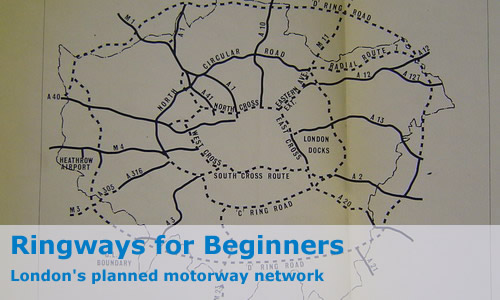Introduction
The main archive for Ringways research, a joint UK roads research project is stored over on CBRD. If you're already familiar with the Ringways, there's the place to go for the full in-depth experience. If you're a newcomer to the whole thing, then read on...
I keep hearing about these 'ere Ringways, what are they all about?
That's the idea of you being here, isn't it.
All smugness aside, the Ringways were designed to be a motorway network for London. There are parts of the plan that were built and exist today, and other parts were bodged together upon cancellation of the plan. In other places, there are strange linear gaps in the urban area, and in others there are lines of "tin shed" development.
All evidence that points towards the grand masterplan that was under development in the 1960s and 1970s.
Haven't I read somewhere about a plan for motorways in London before that date?
Indeed you have - probably on here somewhere!
Motorways in London are not a new thing - in the 1920s there was a plan for an elevated motorway across the city, whilst the late 1930s brought plans for various improvements to London's road network.
The immediate predecessor to the Ringways came from the 1943 County of London Plan and 1944 Greater London Plan, the story of which is more fully told on the A-Ring feature.
Ah yes, very interesting. But what happened next?
Well, in the early 1960s, the then-London County Council sharpened their pencils, and started thinking about roads. Not just any old ordinary road, but a whole plan-full of them. We know that the LCC sat on them, and kept awfully quiet about the whole thing, but slowly plans started to leak out. Before much could be done, the LCC was abolished in 1965, and the Greater London Council formed instead, and they continued the LCC's work. Indeed, if anything they got all over-excited about the whole thing.
To cut a long story short, they (in conjunction with the Ministry of Transport) came up with a whole collection of plans, both for the Ringways themselves, and for the radial routes that would come in from outside London. Generally speaking, the GLC were responsible for the inner routes, whilst the Ministry were responsible for the routes in the outskirts.
Slowly, these plans were revealed, and the sense of horror in various parts of London rose with each successive announcement. Ringway 1 was revealed to the public in 1966, and then Ringway 2 in 1969. At first, the London Boroughs were generally supportive, but as the public mood changed, so did the politicians.
In 1973, following the outcome of the Greater London Development Plan, Ringway 1 reached the Cabinet. In a meeting on 18 February, the plan was approved by the Cabinet. The Ringways were on!
Success for the planners, eh?
You would think so, anyway. This state of affairs lasted a whole two days, before the Treasury killed the whole thing off as simply being too expensive for words.
That's mad!
It is rather, isn't it. The problem then became one of what to do about the outer Ringways. The answer? A bodge.
Oh, what a surprise.
Yes, I'm shocked by that revelation too.
Parts of the two outer Ringways, 3 and 4 were about to start construction. So, the bright idea was brought up that the two rings should be bodged together into one London Orbital. So there you have it: today's M25. Halves of two different ring roads, with bits tacked on to join the two up. Is it really any surprise that it has the reputation it has, with parts of it being widened to six lanes in each direction, with all sort of cleverness to keep it moving; when you realise that it's one bodged loop, when in the 1960s they thought that four proper ones would be necessary?
When you put it like that, perhaps not, no.
So, let's get on with looking at the plans in a bit more detail...

